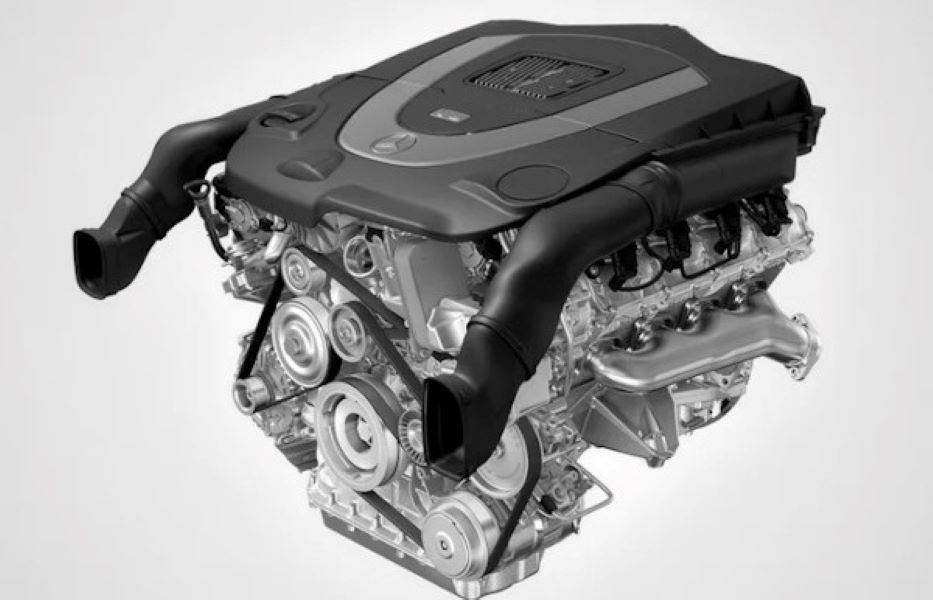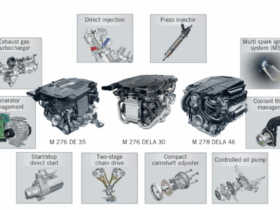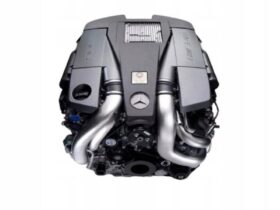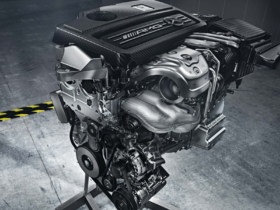Table of Contents
Mercedes-Benz M273 V8 Engine (2005–2013)
The Mercedes-Benz M273 engine is a naturally aspirated V8 produced from 2005 to 2013 as the successor to the legendary M113. Built with all-aluminum construction and variable valve timing, it was designed to deliver smooth, refined performance across luxury sedans and SUVs.
As a transitional engine before the shift to turbocharged powertrains like the M278, the M273 offers a traditional V8 driving experience while introducing modern features. It powered models such as the S-Class, E-Class, CLS W218, G-Class and GL-Class, .
While robust, the M273 is known for certain issues like intake manifold flap failures and timing chain component wear. In this guide, we’ll cover specifications, reliability, common problems, maintenance tips, and model applications.
For a complete overview of all Mercedes powerplants, visit our Mercedes Engine Types Hub.

M273 Engine Variants & Specifications
The M273 was offered in two displacements:
| Variant | Displacement | Power | Torque | Years |
|---|---|---|---|---|
| M273 KE47 | 4.7 L V8 | ~340 hp | ~460 Nm | 2006–2010 |
| M273 KE55 | 5.5 L V8 | ~388 hp | ~530 Nm | 2006–2011 |
Key Features:
- – V8, naturally aspirated
- – Aluminum block & heads with DOHC
- – Variable camshaft timing (VCT)
- – Magnesium intake manifold with variable flaps
- – Compression ratio: 10.7:1 (E47) / 10.5:1 (E55)
- – Fuel injection: port injection
- – Max RPM: ~6,500
The engine delivered linear, smooth power, making it ideal for luxury cruising and refined performance.
Common M273 Engine Problems & Fixes
Like most Mercedes V8s of its era, the M273 develops a few predictable issues over time:
| Problem | Symptoms | Diagnosis & Fix | DIY Friendly? |
|---|---|---|---|
| Faulty timing chain idler sprocket (early units) | Ticking noise, CEL (60–80k mi) | VIN check; replace sprocket if affected | Professional |
| Cam plug oil leaks (pre-2008) | Oil pooling, white smoke | Replace plastic plugs with revised metal versions | Partial |
| Intake manifold VVT flap failure | Rough idle, CEL (P2004/P2006), loss of power | Inspect flaps; repair kit or replace manifold | DIY possible |
| Balance shaft issues (rare in later engines) | Vibration, reduced performance | Inspect shaft sprockets; replace if worn | Professional |
| Idle gear/throttle body malfunctions | Fluctuating RPM, rough idle | Clean throttle body, check idle gear | DIY possible |
Related reads: M278 Engine, M157 Engine
M273 Reliability: Strengths & Weaknesses
The M273 can last well beyond 200,000 km if serviced correctly. It’s less electronics-heavy than later V8s, making it easier to maintain, but it does have age-related weaknesses.
Strengths:
- – Smooth, linear power delivery
- – Solid long-term reliability with care
- – Simpler electronics vs newer turbo engines
Weaknesses:
- – Oil consumption over time
- – Plastic intake components prone to failure
- – Timing chain wear around 150,000 km
Verdict: with preventive care, the M273 is a dependable and enjoyable naturally aspirated V8.
Mercedes Models Equipped with the M273
M273 E47 (4.7 L V8)
M273 E55 (5.5 L V8)

M273 vs M278 : Key Differences
The M278 replaced the M273, introducing turbocharging and direct injection for efficiency and power.
| Feature | M273 | M278 |
|---|---|---|
| Induction | Naturally aspirated | Twin-turbocharged |
| Fuel system | Port injection | Direct injection |
| Power output | 340–388 hp | ~402–429 hp |
| Efficiency | Less efficient | Improved fuel economy |
| Emissions | Higher | Lower (eco-friendly) |
| Performance | Smooth, classic V8 | More torque, faster response |
Verdict: M273 suits enthusiasts of classic V8 smoothness, while the M278 offers modern efficiency and torque.
Maintenance Tips for M273 Owners
Keeping the M273 healthy requires proactive care:
- Oil changes: every 8,000–10,000 km with 5W-40 synthetic
- Timing chain inspection: after 150,000 km; listen for rattles
- Cooling system: check thermostat & water pump for leaks
- Intake manifold: monitor for rough idle; repair flaps early
- Service log: maintain records to track wear & issues

FAQs : Mercedes M273 Engine
Q1: Is the M273 engine reliable?
Yes, if maintained, it can surpass 200,000 km. Watch for timing chain and manifold issues.
Q2: What are the most common M273 problems?
Oil leaks, intake manifold flap failures, timing chain sprocket wear.
Q3: What oil does the M273 use?
Mercedes recommends 5W-40 synthetic (MB spec 229.5).
Q4: Which cars have the M273?
S-Class, E-Class, CL-Class, GL-Class, ML-Class, and G-Class (2005–2013).
Q5: How does the M273 compare to the M278?
The M273 is NA with classic V8 feel; the M278 adds turbos for more torque, power, and efficiency.
Conclusion: Should You Buy a Mercedes with the M273?
The M273 V8 offers a refined, naturally aspirated Mercedes experience. While it requires vigilance with timing chains, cam plugs, and intake flaps, it remains a reliable, smooth engine when properly cared for.
For enthusiasts who value the classic V8 character over turbocharged torque, the M273 delivers timeless Mercedes performance.
See how it fits into the bigger picture in our Mercedes Engine Types Hub
Author
Written by Mercedes Expert
With years of hands-on experience diagnosing and repairing Mercedes-Benz systems, he brings technical depth and practical case studies to help car owners, technicians, and enthusiasts troubleshoot complex automotive issues. His work focuses on clear repair guides, OEM-level procedures, and knowledge-sharing to empower both professionals and drivers.
Last Updated: September 2025










The post was very good, I appreciate how you explain it, Keep the posts coming! Very good talent.
Thank you so much! That really means a lot to me.